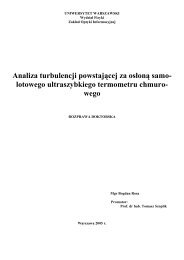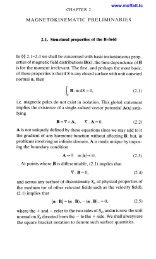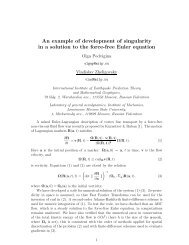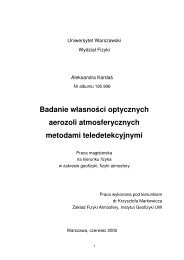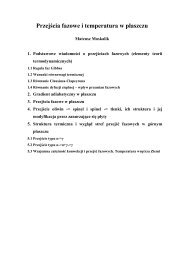A similarity solution for viscous source flow on a vertical plane
A similarity solution for viscous source flow on a vertical plane
A similarity solution for viscous source flow on a vertical plane
You also want an ePaper? Increase the reach of your titles
YUMPU automatically turns print PDFs into web optimized ePapers that Google loves.
38 B. R. Duffy and H. K. Moffatt<br />
FIGURE 1. A trickle of fluid emitted <strong>on</strong> a near-<strong>vertical</strong> plate.<br />
effects of surface tensi<strong>on</strong> cannot be ignored; we c<strong>on</strong>sider this case here, again taking the<br />
film to be thin and the <str<strong>on</strong>g>flow</str<strong>on</strong>g> to be slow.<br />
Suppose a thin film of Newt<strong>on</strong>ian liquid, of c<strong>on</strong>stant density ρ and viscosity µ, is <str<strong>on</strong>g>flow</str<strong>on</strong>g>ing<br />
down a <strong>plane</strong> inclined at an angle α to the horiz<strong>on</strong>tal, α being defined such that the liquid<br />
is <strong>on</strong> the ‘topside’ of the <strong>plane</strong> when α <br />
π and is <strong>on</strong> the ‘underside’ of the <strong>plane</strong> when<br />
α <br />
π (see Figure 1). We shall take the <strong>plane</strong> to be <strong>vertical</strong> or nearly <strong>vertical</strong>, so that α <br />
π<br />
is zero or is small.<br />
We use Cartesian coordinates Oxyz as in Figure 1, with Ox down a line of greatest slope<br />
and with Oz normal to the <strong>plane</strong>. A standard thin-film analysis shows that the (generally<br />
unsteady) free-surface profile z h(x, y, t) satisfies<br />
3µh t<br />
[h(ρgh cos αγ h)]3ρgh h x<br />
sin α, (2.1)<br />
where γ denotes the coefficient of surface tensi<strong>on</strong> (assumed c<strong>on</strong>stant), g denotes the<br />
accelerati<strong>on</strong> due to gravity, and suffixes denote partial differentiati<strong>on</strong>.<br />
The case of a rivulet of uni<str<strong>on</strong>g>for</str<strong>on</strong>g>m width is obtained by putting h h(y) and setting to zero<br />
the term in square brackets in (2.1):<br />
ρgh cos αγh yy<br />
c<strong>on</strong>stant.<br />
(cf. Towell & Rothfeld, 1966; Allen & Biggin, 1974). This is to be integrated subject to the<br />
boundary c<strong>on</strong>diti<strong>on</strong>s<br />
h 0 and htan β <br />
at y a,<br />
where a is the semi-width of the trickle, and β <br />
is the c<strong>on</strong>tact angle at the air–liquid–solid<br />
c<strong>on</strong>tact line, taken to be c<strong>on</strong>stant. For small α <br />
π the <str<strong>on</strong>g>soluti<strong>on</strong></str<strong>on</strong>g> is<br />
h(y) tan β <br />
2a<br />
(ay).





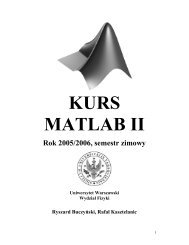
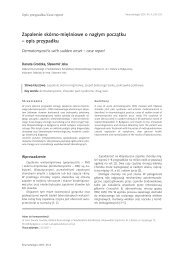
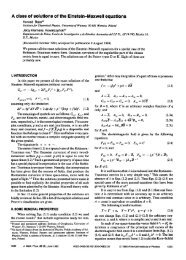
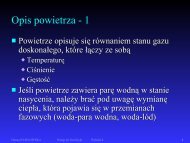
![slajdy [PDF, 0,6 MiB] - Instytut Geofizyki](https://img.yumpu.com/22546539/1/190x143/slajdy-pdf-06-mib-instytut-geofizyki.jpg?quality=85)
